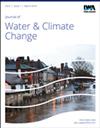Assessment of climate change impacts on hydrological processes in the Usangu catchment of Tanzania under CMIP6 scenarios
IF 3.1
4区 环境科学与生态学
Q2 WATER RESOURCES
引用次数: 0
Abstract
Abstract Climate change is anticipated to have long-term effects on hydrological processes and patterns that lead to water stress in agroecological catchments. Climate change escalates water scarcity in the Usangu catchment, evidenced by the drying up of rivers during the dry season. Therefore, this study was undertaken to assess climate change impacts on hydrology by utilizing the Soil Water Assessment Tool (SWAT) model and an ensemble mean of five Global Circulation Models (GCMs) under two shared socio-economic pathway (SSP) emission scenarios. Downscaling of GCMs was performed by the LARS-WG statistical downscaling tool. In comparison to the baseline period, short rain intervals are expected to occur between 2030 and 2060, with a mean annual precipitation increase of 7 and 17% in SSP 2–4.5 and SSP 5–8.5, respectively. Maximum and minimum temperatures are expected to rise by 0.6–2 °C. Corresponding to future temperature increases, evapotranspiration would increase to about 30% and decrease water yield and groundwater recharge by 7 and 26% in SSP 2–4.5 than in SSP 5–8.5. However, the effect of precipitation increase is shown by increased surface runoff and streamflow during wetter months. These findings provide watershed managers with crucial information for planning and managing the catchment in light of a changing climate.CMIP6情景下气候变化对坦桑尼亚Usangu流域水文过程影响的评估
气候变化预计会对水文过程和模式产生长期影响,从而导致农业生态集水区的水资源压力。气候变化加剧了乌桑古流域的水资源短缺,旱季河流干涸就是明证。因此,本研究利用土壤水分评估工具(SWAT)模型和5个全球环流模式(GCMs)在两种共享社会经济途径(SSP)排放情景下的综合平均值,评估了气候变化对水文的影响。采用LARS-WG统计降尺度工具对gcm进行降尺度。与基线期相比,预计2030年至2060年将出现较短的降雨间隔,在SSP 2-4.5和SSP 5-8.5期间年均降水量分别增加7%和17%。最高和最低气温预计将上升0.6-2摄氏度。与未来温度升高相对应,SSP 2-4.5的蒸散发量将比SSP 5-8.5增加30%左右,产水量和地下水补给将分别减少7%和26%。然而,降水增加的影响表现在湿润月份地表径流和河流流量的增加。这些发现为流域管理者在气候变化的情况下规划和管理流域提供了重要信息。
本文章由计算机程序翻译,如有差异,请以英文原文为准。
求助全文
约1分钟内获得全文
求助全文
来源期刊

Journal of Water and Climate Change
WATER RESOURCES-
CiteScore
4.80
自引率
10.70%
发文量
168
审稿时长
>12 weeks
期刊介绍:
Journal of Water and Climate Change publishes refereed research and practitioner papers on all aspects of water science, technology, management and innovation in response to climate change, with emphasis on reduction of energy usage.
 求助内容:
求助内容: 应助结果提醒方式:
应助结果提醒方式:


